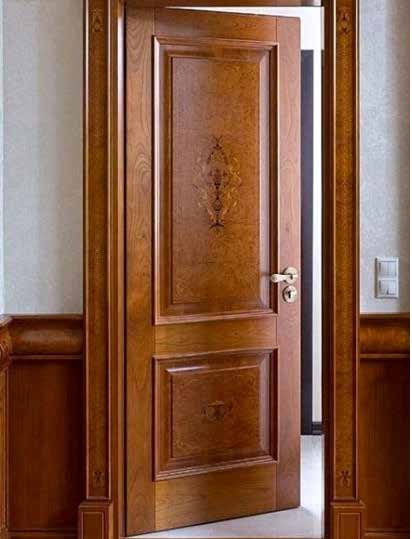The Door industry in India is scattered and comprises of small – medium manufacturers. The construction industry is also improving
its techniques and is guaranteeing accurate openings in walls to accommodatethe Pre Hung Doors ofrequired sizes.
Indian Doors Market size was valued at over USD 1.2 billion in 2016 and will surpass 9.5 million units by 2024.
Pre- Hung Doors- characteristics and advantages
A pre-hung door simply means that the door is already mounted onto the frame, which saves you all the work of mortising the frame and the door to accommodate the hinges at the site. The surface finish and the workmanship of such door is very good as the entire work is done in the factory using professional machines and portable tools.
Right & Left Hand Pre –Hung Doors :
To Determine whether the door is right hand or left hand, just stand sideways in the door frame with your back to the hinge side of the frame and visualize which way it will open. If it swings to your left, it is a left-hand door. If it swings to your right, it is a right-hand door. A slab door is what we normally think of when we think of doors… just a rectangular slab of wood, or wood composite. It has no hinges or hardware. It’s up to the installer to attach it to the doorframe with hinges.
Solid Wood Doors & Hollow Core Flush Doors:
Let us see in the following paragraphs the Manufacturing process of Hollow Core Door.Solid Wood core & Hollow core Flush Door are assembly of wooden components, which are manufactured using accurately Dried timber of required Species / hollow core chip board, which are dimensionally stable and do not warp. The components of a door are
- Outer frame of dried timber of required thickness / Chip board section.
- Core filling material like edge glued board, Chipboard, Hollow chipboard.
- Solid Hardwood Edge banding 8-10 mm thick (If required)
- Lock rail for fixing the lock.
- Block for Eyehole fixture.
- Face panel of 3 mm or 3.5 mm HDF or embossed door skin.
- Decorative face materials like Veneer laminate HPL, Coated paper, PVC foil or solid wood panel of 6 to 8 mm thickness.
- The Doorframe is made of softwood / MDF composite board. It is wrapped with the matching face material like veneer, Finish foil etc.

[Photo courtesy Sauverland Board]
The outer frame is made using dried soft wood timber of 8% – 10% moisture content. It is stored under cover in standard sections as per requirement of the frame size. One has to check the moisture at the core of the timber.
The selected timber is passed through Four-side planner Molder / Two side planner for accurate dimensioning of the same. The grooving cutters are mounted on the vertical spindle of the machine to make a groove that allows the release of expansion of air in the core of the door. The timber is cut to accurate length using a Double dimension Cross Cut Saw.
To eliminate the risk of wet timber and to save processing labour and time Chip Board sections are used in the making of the frame for doors. Solid wood inserts
are used to strengthen the places of Door lock, hinges etc. Hard wood inserts are used for this purpose. This is more popular in Europe as it does not make any difference in strength, screw holding capacity or the life of the door.

These sized sections are clamped & stapled together to form the frame. Tubular board, chipboard or Edge glued panels are places in the assembled outer frame.
The door skin can be either 3 mm or 3.5 mm thick plain HDF or door skin is required. It should be noted that glue is applied to skin and not the core board.The wooden frame with filler material is sandwiched between two glued door skins & is pressed in the hot press. There are three options for pressing.
- Single daylight press
- Multi daylight press with in and out feed system
- Fully Automatic continuous Pressing line for 1000 doors per shift. Picture below is a hydraulic press with loading and un-loading system. Pre assembled doors are loaded on the in feed conveyers.

The assembled doors are loaded in the hot platens. The pressed doors are unloaded and are sent for cooling to make them ready for next operation. It takes about 4 to 5 minutes to complete one pressing cycle.
Automatic Continuous Press is also available for a high production capacity that canproduce over 1000 doors per shift. The doors are allowed to cool down to room temperature to make them ready for next operation of accurate sizing. The accurate sizing can be done on DET (Double end Tenoner) or on CNC Router depending upon the capacity required. The doors are passed through DET machines that are placed in line at 900 apart to perform sizing of both length and width of the door
Two DET machines are connected with conveyer inline to feed the door. This machine can have heads to do cutting, molding, sanding, grooving in one passage. In
one passage the door is made ready for next process. The sizing can also be done by CNC machining centre with tool changer and angular head. The machine can size the door and also groove for lock, hinge etc. This is a flexible solution.
In case of high-end doors, they are then edge banded with matching edge material. This can be done with single side edge bander with 4 passages or we can put two
machines in line as an economic option. In this one machine is right hand feed and other left hand feed. The machine can have option of 6 – 10 mm solid wood edging and up to 3 mm PVC edging.
After sizing the doors are edge banded and calibrated for uniform thickness and smooth finish. This can be done on single side sanding machine or on Top Bottom
sanding machine for higher production capacity. In single side sanding machine one has to turn the doors to sand from other side. The surface becomes ready for upgrading with veneer / finish foil / HPL etc as per the requirement. This is done for high-end doors. For economyrange doors we can use one side Pre laminated HDF.
In some cases the wrapping of finish foil / Coated paper / PVC foil is done around the door.

In many cases the hardware grooving and fixing is done after final painting is done. With this we save the labour of covering the lock grooves, hinge seats to avoid the over spay of paint. And remove the same after painting is over.
The doors are then painted with desired finish like PU / Water based lacquer etc. The painting is done with an automatic door-painting machine. In this machine the door is painted from all the sides and then it is turned and painted on the other side. Like this the complete door is painted in one cycle. The door is then stored in clean room for drying. Intermediate sanding is done with 250to 360 grit open coat abrasive paper. Abernet paper from 3M is the best as all dust is sucked through paper keeping the area clean. We can alternatively use a conveyerised painting line in which the doors are hanged and travel on the conveyer. Two painters / automatic
painting arms are placed on two sides to do the painting. Intermediate sanding is a must for good finish.
The door is passed through drying oven for quick drying of the paint. The oven can be IR (Infra Red) or UV (Ultra Violet). The doors are sanded from both the sides in wide belt sanding machine / 3D sanding machine with fladder drum / Scotch bright drum. After cleaning with high-pressure air the doors are ready for the final topcoat. The topcoat is painted with clear lacquer in pressurized room to protect it from dust particles. Now the doors are ready to make the hardware placement slots. For higher production capacity, we suggest an automatic CNC Processor, which will make the lock grove, eyehole and the seats for the hinges in one passage. This is a through feed machine with machining centres& drilling heads on both the sides. Hence the door is worked on both the sides simultaneously. Lock groove, Hinge seat (both anuba and book type hinges) are made on the machine. The drilling head does all the drilling needs. We can have an additional head to fix anuba type hinges in the same holding. Thus the door is ready for fixing the lock that is done in the same passage.

One door is completed in less than one minute with all the working like lock groove, hinge seat, drills etc. One operator is enough for the working.
The Hinges shown in the above picture are very popular in Europe as they are strong, easy to fix, smooth movement for longer life and low priced. They need just two holes at an angle in the door and doorframe.
Automatic hinges fixing machines are available which does the drilling and fixing of the hinges in one go only, but this is done after the finishing of the door.
.


The door is mounted on the frame and packed with protective film and bubble film to avoid the transit damages. All necessary fixing hardware like Anchor bolts, caps, screws are packed along with detailed installation instructions. A link to installation video will be good from the marketing point of view.
The doorframe is manufactured in solid wood / plywood or engineered wood in three-piece design to accommodate the varying wall thickness. It is seen in India that the doorframes and doors warp during the season change. This
problem can be overcome by making the engineering wood frame that makes the frame more stable as compared to solid wood frame. The doorframe is made in secondary timber species and profiled in the Four Side Moulder to required design. It is then wrapped with matching veneer / Mono laminate / Finish foil etc in a wrapping machine.

Door Frame section wrapped with veneer
As shown in the above picture the doorframe section is an engineered frame with wood and MDF. All the three components are manufactured separately. The main frame is manufactured by joining three layers. Solid wood section is sandwiched between two MDF layers to assure a stable section and also impart smooth finish after veneering.

Wrapping machine that uses PVA / PUR adhesive is used for the wrapping of the doorframes. The architraves are manufactured by joining two MDF sections and then machined to required profile. They are then wrapped in the above machine and followed by lacquering.
The section can be miter cut with dowel hole to assure a perfect joint. Accurate length cutting is done to match the door height. The frame is then passed through CNC milling machine or jigs for lock & hinge hole grooving.
This process is done after painting to avoid the masking of the routed surface.

The finished doorframe is fitted with rubber extrusion (to make the door sound proof), hinges, lock fittings etc. They are then wrapped in Bubble film with stretch wrapping. The engineered doorframes are also made from MDF/ Plywood sections pressed together &molded to desired shape & profile and processed for wrapping & finishing.
This is combination of materials like solid wood, MDF, Chipboard, Plywood that are jointed together to form the required
door section. The combination is selected as per the market requirement. As these lines for the manufacture of Engineered Door Frames are quite complicated, setting up a production unit for pre-hung doors calls for large investment.
For any additional information please
contact: shanti@woodconconsultants.com
Photo courtesy SCM

